There are 30 good companion plants for Brussel sprouts in this list, including a variety of herbs, vegetables, and flowers.
Brussels sprouts are a vegetable in the biological family known as Brassicaceae, the cabbage family. It is a biennial plant (one that completes its life cycle in two growing seasons and then dies) just like some other plants within its family.
The vegetable is grown for its buds which are edible. Its greens, which look like very small cabbages, are usually about 1.5 to 4 cm (0.6 to 1.6 in) in diameter. It is cultivated mostly in Europe (Netherlands, Germany and the United Kingdom), Mexico and other parts of North America like the United States.
Brussels sprouts, when consumed raw, consist mostly of water, small amounts of carbohydrates and lesser amounts of protein and fat. Nutrients they contain include vitamins A, B1 (thiamine), B2 (riboflavin), B3 (niacin), B5 (pantothenic acid), B6, B9 (folate), C, E and K, calcium, choline, iron, sodium, magnesium, manganese, phosphorus, potassium and zinc.
For their consumption, the buds are usually removed from the stalk, surplus stem of the Brussels sprouts cut, loose surface leaves peeled and discarded, and the buds then cleaned. They may be cooked by boiling, grilling, roasting, slow cooking, steaming or stir frying.
The plant is best grown in full sun and rich, consistently moist soil. Deep watering is needed at intervals to maintain soil moisture. Like other brassicas, it is susceptible to the fungal disease known as clubroot and the infestation of insects.
There are several other crops which may be planted with the Brussels sprouts in your garden to encourage their growth, help keep pests away from them, attract useful insects to them, help the soil with nutrients, provide ground cover or shade them from excess sunlight.
Such grouping for the purpose of sharing benefits is called companion planting. It is a tried and true method, ensuring for years that crops are grown with some other crops that help them grow healthy.
In this article, you will learn about thirty (30) good companion plants and thirteen (13) bad companion plants for Brussels sprouts in your garden. Also explained below are reasons why they are or are not ideal beside your plant.
Table of Contents
Good Companion Plants for Brussel Sprouts
1. Basil
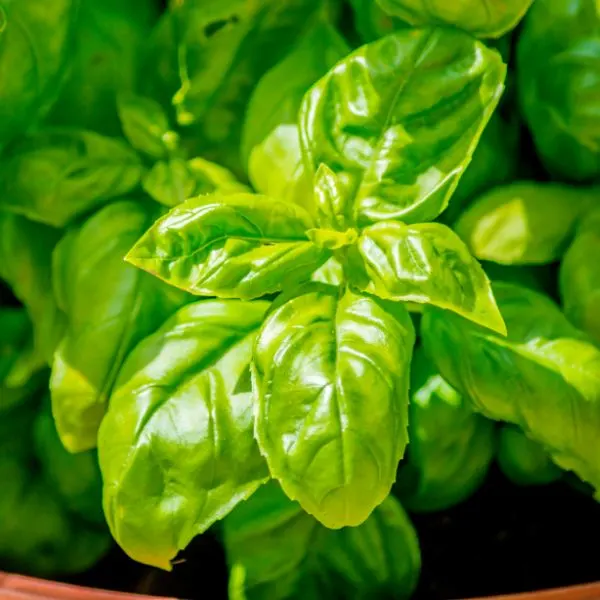
Basil is a herbaceous flowering herb belonging to the mint family Lamiaceae. Also referred to as great basil, it has a sweet, spicy and slightly peppery flavor. It is cultivated for its leaves and flowers that are used for food in several cuisines.
The seeds of this culinary herb may also be soaked for use in drinks and desserts. Just like other herbs, basil is very aromatic and has a strong smell. It contains oils in the leaves that can be released by gentle touch.
The odor of basil can keep certain pests and rodents away from your Brussels sprouts and the other companions it has around. The tender plant brings some other benefits to your garden plants.
One benefit of planting basil alongside Brussels sprouts is that basil attracts beneficial insects to your garden. Butterflies and a number of other insects that aid pollination or eat harmful crop pests are attracted to this plant.
In addition to bringing useful insects to your Brussels sprouts, basil is also repellent to several harmful insects. Aphids are known to attack brassicas but basil keeps them away. It also deters beetles, hornworms and white flies from other plants.
Some other insects that are repelled by this herb include asparagus, carrot flies, mosquitoes and worms. Rodents like mice and rats are turned off by its smell. Basil needs its own pests kept away as well, so you can plant chamomile, chives and marigolds around it.
Like Brussels sprouts, basil thrives in full sun. Although the plant likes to grow under full sun, it needs shade to avoid being scorched. It also requires its soil to stay moist and the shade can aid this.
2. Beets
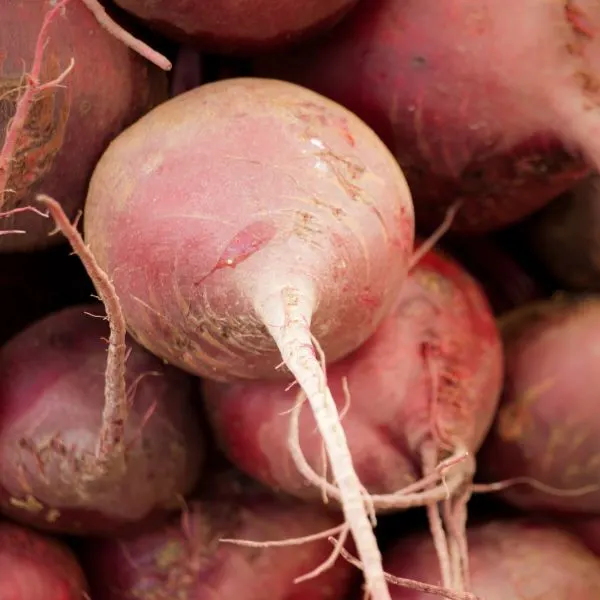
Beets are flowering plants in the amaranth family grown for their edible taproots, called beetroot, and leaves, called beet greens. This species goes by several other names, including dinner beet, garden beet, red beet and table beet.
They produce an edible and usually deep red taproot. The leaves of these plants may also be prepared and eaten as vegetables. Beet plants are good companions for Brussels sprouts.
Brussels sprouts require a lot of calcium from the soil to grow very well. Compared to some other plants, beets take up only a little amount of calcium from the soil, reducing competition with these plants and allowing them enough of this nutrient.
In turn, Brussels sprouts aid the growth of beets. They do this by enriching the soil with nutrients, helping your beets grow and grow properly. The two plants are very friendly so it is ideal to grow them together.
Growing Brussels sprouts and beets together also works as both plants fare well in similar soil: rich, consistently moist but well draining. They both do not like very dry soil or soggy soil because these conditions harm them.
While planting them together, take care to space them well or add in some other insect repellent plants. This is because both beets and Brussels sprouts are susceptible to attacks from insect pests.
Some of such pests include aphids, beetles, cutworms, leafhoppers and webworms. Also, beets enrich the soil in turn for the healthy growth of Brussels sprouts. They help boost the fertility of the soil as they add magnesium.
3. Bush Beans
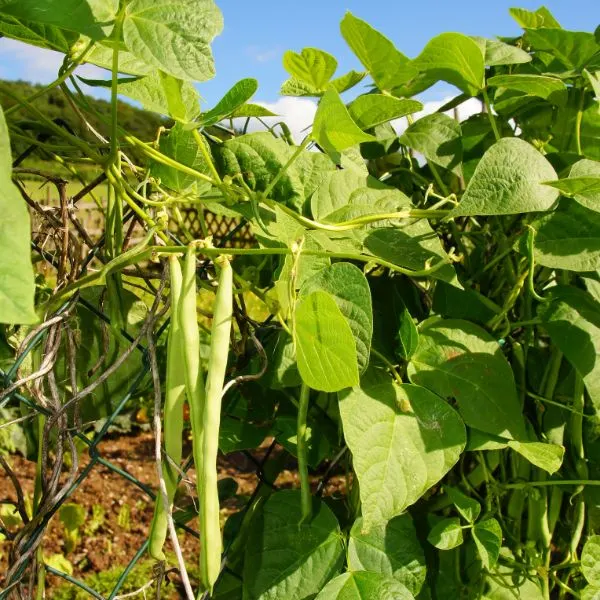
These are seeds of several genera of flowering plants that belong to the botanical family Fabaceae (the pea family). Bean seeds (pulses) are then boiled, fried, baked or cooked by some other method and used as vegetables for humans or animals to eat.
Beans are good companion plants for Brussels sprouts as they are legumes, plants with nodules in their roots that help fix nitrogen in the soil. They improve the quality of the yield of other plants because they supply nutrients to the soil.
This is especially true of Brussels sprouts because the plants require very good amounts of nitrogen to grow properly. By planting bush beans near it, your Brussels sprout plant can get this key nutrient that it needs.
Beans can also help in your garden by providing good ground cover. By doing so, they help to prevent water loss that results from evaporation. They also prevent and reduce the growth of weeds that will otherwise spring forth in that area.
To help replenish soil nutrients and provide ground cover for your Brussels sprouts in the garden, it is advisable to plant legumes alongside them. Beans, bush beans specifically, are examples of such leguminous plants which are healthy for your plant.
Brussels sprouts and other brassicas (plants in the cabbage family) use up quite a lot of nutrients in their development. Legumes fix the soil with nitrogen and help to restore the nutrients that such plants have taken up.
4. Carrots

Carrots are good companion plants for Brussels sprouts. They are edible root vegetables with usually orange taproots and green leaves at the top. Cultivars in white, yellow, red, purple and black also exist, with this root typically tapering.
These edible root veggies can enhance the flavor of Brussels sprouts. The main issue with planting them side by side is that they are both susceptible to attacks from insects like aphids and carrot flies.
A solution is to grow plants like mint and rosemary alongside the pair to control pests. Mint is a good repellent of carrot root flies, with a strong aroma that masks the scent of growing carrots. In doing so, it confuses these pests and gives young carrots a chance.
Rosemary masks the smell of carrots and so carrot flies would be unable to detect these plants. Carrots can in turn help your rosemary plants thrive by controlling the presence of weeds that compete for soil nutrients in your garden.
Controlling weeds is a benefit that Brussels sprouts also enjoy due to the presence of carrots in your garden. Be sure to add in any of the herbs mentioned above to the pair as you grow them in your garden.
5. Celery
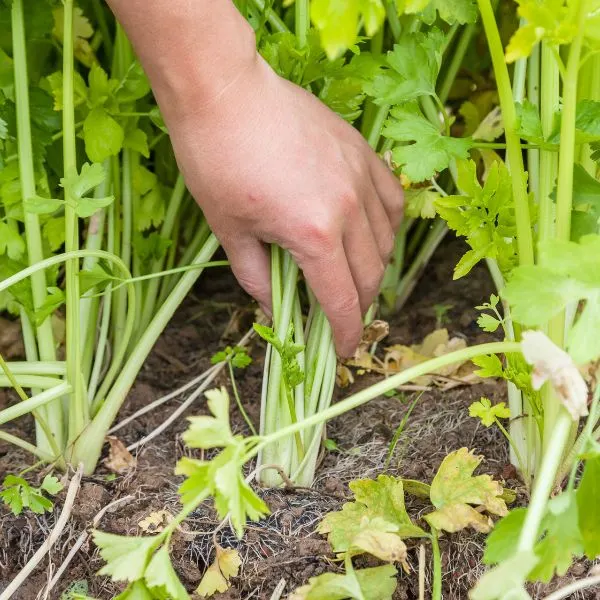
Growing celery beside Brussels sprouts is very beneficial to the latter. It is ideal to grow celery with any vegetable in the Brassicaceae family, such as broccoli, cabbage, cauliflower, kale and kohlrabi.
Celery has aromatic leaves that deter pests like the white cabbage moth. White cabbage moths are known for causing serious harm to the leaves of Brussels sprouts and the others. Moreover, celery draws useful insects to your plant.
Some of such beneficial insects include lacewings, ladybugs, parasitoid wasps and other parasites of aphids. Celery attracts hummingbirds too, which feed on pests of Brussels sprouts.
Despite the fact that this plant is a water hog (one that needs a lot of water to grow properly), celery leaves enough nutrients in the soil for your Brussels sprouts. It keeps pests away, attracts beneficial insects and lets your plant take up necessary nutrients.
6. Chard

Also known as Swiss chard, chard is a leafy green vegetable that you can comfortably plant next to the Brussels sprouts in your garden. These plants do not necessarily provide each other with nutrients or help protect each other from pests.
They are good companions on the basis of convenience. For instance, planting other brassicas near your Brussels sprouts can cause them to battle for nutrients in the soil as they have similar requirements.
In the case of chard, it requires different nutrients from the soil than brassicas do. They might not boost each other but chard provides good ground cover, creates a friendly space in your garden and does not need the same nutrients.
7. Chamomile

Also spelt camomile, chamomile is a flowering plant of the daisy family Asteraceae. Some parts of this plant are used in the making of healthy beverages because of its antioxidant properties. It resembles a daisy.
Chamomile is popular for being a flavor-enhancing companion plant to several crops cultivated alongside it. It can improve or enhance the taste or flavor of your Brussels sprouts.
In addition to this, chamomile can also aid the growth of the Brussels sprouts planted around it by repelling flying insects like mosquitoes while at the same time attracting beneficial ones like honey bees, hover flies, ladybugs and parasitoid wasps.
The plant repels harmful insects with its scent and brings the useful ones by its small, beautiful flowers which resemble daisies. It will help to be mindful when planting chamomile near Brussels sprouts.
This is because the plant spreads quite quickly. Only aim for one plant approximately every 150 feet within your garden space to avoid unnecessary competition that will likely adversely affect your Brussels sprouts.
8. Cilantro

Known also as Chinese parsley, coriander or dhania, cilantro is an annual flowering plant with edible plant parts. The fresh leaves and dried seeds of this aromatic herb are the parts most used for culinary purposes.
One of the many herbs suitable for growing alongside or with Brussels sprout is cilantro. This is because the growth needs of these two are quite alike. Both cilantro and Brussels sprout require full exposure to sunlight and consistently moist but not soggy soil.
Cilantro on its own can keep pests away from your garden, but adding in another herb like mint is a lot more effective in keeping harmful insects away. The relationship deters aphids, cabbage loopers, flea beetles, flies, moths, potato beetles, spider mites and other pests.
The insects above and many more are very inhibiting to the growth and development of Brussels sprouts. Keeping them away will do the brassica a lot of good. As a biennial plant, Brussels sprout only flowers after two growing seasons.
Cilantro has stunning flowers that attract both pollinators and insects that prey on pests. Some of these beneficial insects are: bees, hoverflies, lacewings, ladybugs, parasitoid wasps and tachinid fly larvae.
Growing cilantro and Brussels sprouts together proves to be a lot more beneficial to the latter. Cilantro helps the growth of Brussels sprouts by keeping pests away from them and attracting useful insects like pest parasites and pollinators.
9. Cucumber

The cucumber plant is a creeping vine that bears cylindrical fruits which are used as vegetables for culinary purposes or eaten raw. Cultivating cucumber and Brussels sprouts side by side turns out to be a very good practice.
Because cucumbers are vine plants that need ground space to crawl and Brussels sprouts are more compact, planting them together helps maximize space in your garden. This way, cucumber serves as ground cover.
Brussels sprouts are also fairly protected from diseases and pests with cucumber plants around. The strong, sharp odor of cucumbers keeps cabbage root flies away. They also contain a compound, known as cucurbitacin, that stops the growth of fungal diseases.
Cucumbers also fare well beside Brussels sprouts because the both plants have similar growth needs. Cucumbers can tolerate partial or full shade but they prefer exposure to direct sunlight for six to eight hours daily.
In the same vein, your Brussels sprouts grow best under full exposure to sunlight. The only slight difference is that while the brassicas need intervallic and even watering, cucumbers like lots of moisture and should be watered regularly.
You should be careful when planting them together because both plants are heavy feeders. Cucumbers may compete with Brussels sprouts for soil nutrients and sunlight. They may end up taking up nutrients like nitrogen that Brussels sprouts need.
To ensure your brassica is not left malnourished, it will be helpful to plant leguminous plants like bush beans and peas around to increase nitrogen levels in the soil. Adequate spacing should also be given.
10. Dill
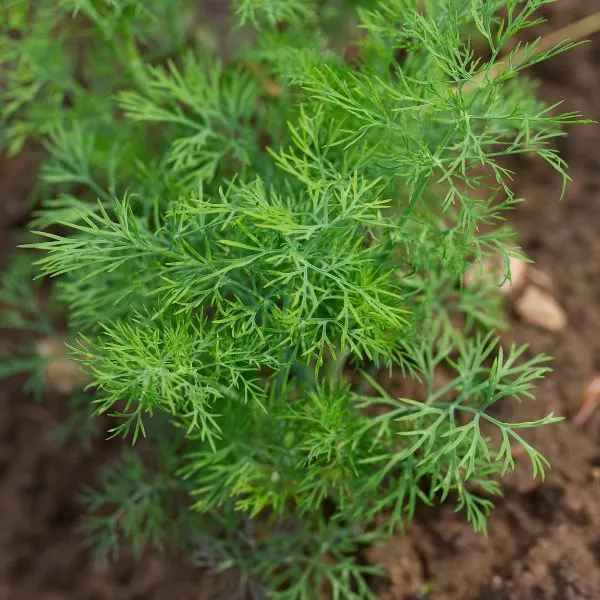
Widely grown in Europe and Asia, dill is an annual herb in the celery family cultivated for its leaves and seeds. These may be used as herbs or as food seasoning. Dill is another example of good companion plants for Brussels sprouts.
To be most beneficial, dill needs to have produced flowers. Its flowers attract beneficial insects to your plant. Some of such insects are like bees and butterflies which help with the process of pollination and reproduction.
Dill also draws insects that feed on the pests of your Brussels sprout, improving your plant’s health. Such predators include hoverflies and ladybugs that eat aphids and wasps which lay eggs to destroy aphids and caterpillars.
Pests like aphids like to chew on the leaves of plants in the cabbage family. This impairs the plants’ growth as their leaves are needed for photosynthesis. Aphids tend to dislike strong-smelling plants like herbs and alliums.
In addition to attracting beneficial insects to your garden, dill is a good companion plant for your Brussels sprout because they both have corresponding soil and care requirements. This companionship is therefore comfortable.
Both plants need direct exposure to full sun and consistent, even moisture to maximize their potential. They like to be grown in rich, moist but well draining soil.
This herb fosters the growth of your Brussels sprouts also because of the long or deep taproots that dill has. They break up and loosen heavy soils. This reduces the chances of weed growth and helps the roots of Brussels sprouts spread.
11. Fennel
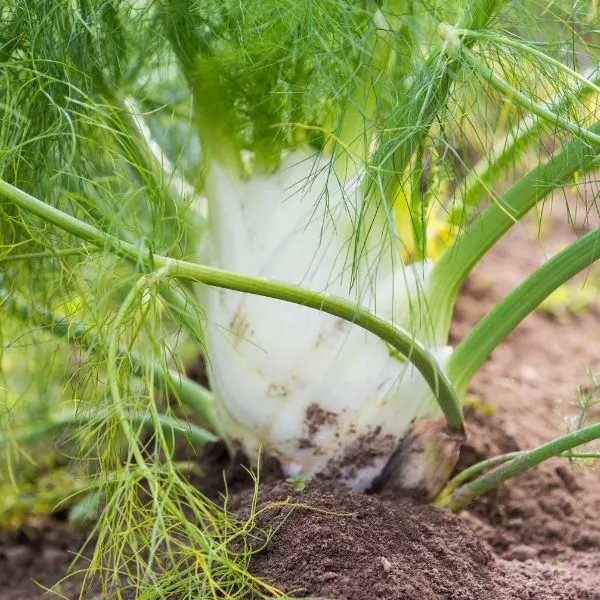
Although fennel should not be planted next to dill in your garden, it is also a good companion for Brussels sprouts. It is not suitable beside many other plants but Brussels sprout is an exception.
Fennel is a species of perennial flowering plants in the carrot family Apiaceae. The hardy plants are used as herbs. Their flowers are yellow and their leaves feathery.
The beautiful yellow flowers of fennel can, like dill, attract useful insects to your Brussels sprouts. They attract some like butterflies which are agents of pollination. They also bring parasitoid wasps and ladybugs to the garden.
This herb also attracts more beneficial insects such as bees of different types (like bumble bees, honey bees, wild bees), beetles, flies, hoverflies and wasps to your apple trees. Bees, beetles, flies and wasps aid pollination.
Ants, aphids, caterpillars, crickets, frog hoppers, mealybugs, mites, nematodes, protozoans, scales and spiders are some pests that the predators named above feed on. Growing fennel can reduce their infestation in your garden.
Parasitoid wasps lay eggs and in their larval stage, these young kill aphids and caterpillars. Ladybugs also feed on aphids. Also, fennel and Brussels sprouts will not be in competition for water and root space.
Fennel is an allelopathic plant, a plant that produces some allelochemicals. Allelochemicals are biochemicals that affect the growth processes (like germination and reproduction) and survival of other organisms negatively or positively.
The allelochemicals that fennel produces make it undesirable for companionship with many other plants, as they tend to have negative effects on and inhibit the growth of such crops. For this reason, it is advisable to plant it at least 1 foot away.
12. Garlic
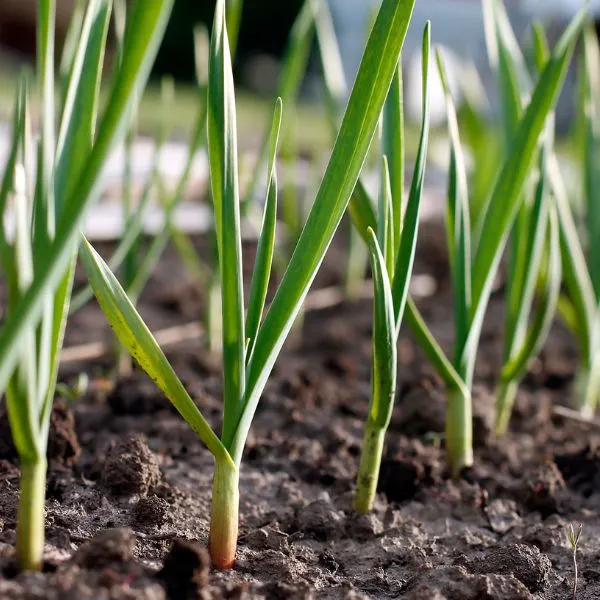
Garlic is a flowering plant in the genus Allium, alongside chives, leeks, onions and shallots. It produces a pungent or sharp smelling bulb divided into cloves which is used to season food or make an oil used by spraying to deter pests.
The oil made from this herb is known as garlic oil. It contains allicin, the chemical that lends it its smell and makes it effective for the treatment of several ailments. Garlic and other alliums make good companions for Brussels sprouts.
The plant provides benefits not only to Brussels sprouts but to other crops around it. It produces an antifungal sulfur compound and then releases this into the soil. This prevents fungal diseases like Fusarium wilt, root root and stem rot.
It does so by boosting the plants’ resistance to soil borne fungi that cause the aforementioned diseases. The sulfur that this plant emits is a fungicide (a substance that helps protect your crops from fungal diseases).
Some pests that garlic can also keep away from the garden are: deer, fungus gnats, Japanese beetles, rabbits and snails. Also, garlic is friendly beside Brussels sprouts as it does not take up too much nutrients or need too much water.
It is not the most picky crop to grow. As long as it gets full exposure to sunlight and just enough water to avoid stress from drought or bulb rot from overwatering, the plant tends to be comfortable.
While garlic is a great pest deterrent on its own and known to repel several pests including aphids, cabbage loopers and spider mites, adding another herb like mint with your garlic and Brussels sprouts provides more pest repellent benefits.
13. Geraniums
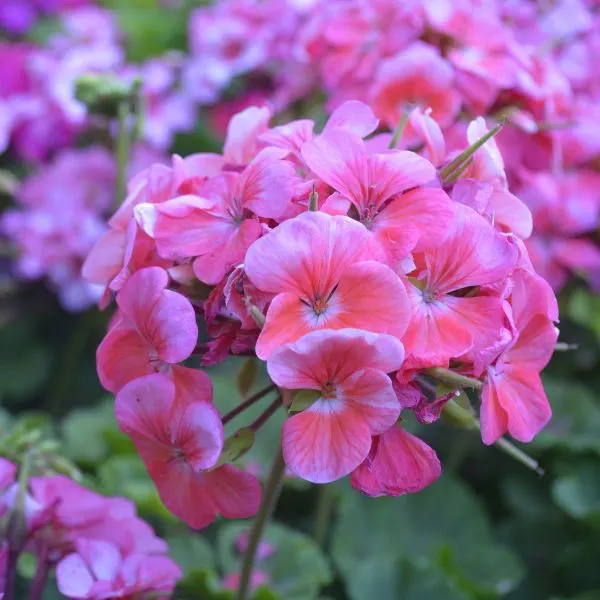
Geranium is a genus of about 422 species of flowering plants also known as cranesbills. They may be annual, biennial or perennial plants and are grown in tropical parts of the world. They bear a long, narrow fruit resembling the bill of a crane.
Most geraniums, especially the annual species, need full exposure to sunlight for proper growth and development. They do love moist soil but it is advisable to let their soil dry a little before watering again to reduce the risk of overwatering.
Geraniums serve as good companion plants for Brussels sprouts. The two plants are first compatible because their soil and growth needs are alike. Brussels sprouts also need full sun, even watering and moist, well draining soil.
Cranesbills also help control pests, attract pollinators and contribute to the health of the soil. The role of pest control is played both by the geranium itself (by its scent) and by some of the pollinators that it attracts.
With their peppery, sharp and biting scent, geraniums repel different insects that harm brassicas, like aphids, cabbage worms, cabbage loopers, earworms, flea beetles and Japanese beetles. Left unchecked, these pests can feed on your Brussels sprouts.
Some pollinators like hummingbirds, which geraniums can bring into your garden, prey on insect pests like ants, aphids, mosquitoes and wasps which are really injurious to the health of Brussels sprouts and other brassicas.
The beautiful flowers that geraniums produce come in many different colors like lilac, red, pink, purple and white. They attract butterflies and hummingbirds. These aid pollination, which is the reproductive process of your Brussels sprouts.
14. Hyssop

Hyssop is a herbaceous flowering plant in the mint family Lamiaceae. It has aromatic, pungent leaves. The parts that grow above the soil may be used in the making of perfumes and herbal medicine or as a seasoning for culinary purposes.
The herb hyssop is another plant that attracts beneficial insects to your Brussels sprouts. These beneficial insects include pollinators like butterflies and bees. It also distracts pests of this brassica by drawing them to itself.
Plants like these are called trap crops. They are used as a sort of distraction to reduce the amount of damage that would be done to the other crop in their absence. Hyssops, in this case, attract the pests to themselves, reducing their impact on your Brussels sprouts.
Insect pests like caterpillars, flea beetles and slugs affect the both crops. They are also great together because they need similar growing conditions: exposure to full sun and moist, well drained soil that is not soggy.
Hyssop also attracts useful insects that feed on pests of your Brussels sprouts. It does this with its flowers which are most commonly purple, although there are some individuals which have white or pink flowers.
The pest predators turn out to also be the pollinators, like bees, beetles, butterflies, hoverflies and parasitoid wasps. Hyssop itself produces aromatic oils that repel cabbage moth larvae, flea beetles and slugs.
When planted densely, hyssop also serves as ground cover. It shields the soil from excess evaporation, retaining its water content. It prevents the growth of weeds which can compete with your plants for and deplete nutrients in the soil. It is a very good companion plant for your Brussels sprouts.
15. Lettuce
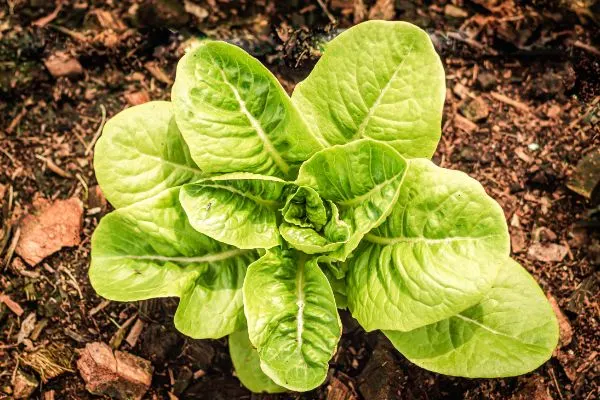
Also grown for its stem and seeds, lettuce is a flowering annual plant mostly cultivated for its leaves and used as a leaf vegetable. It is most often eaten in salads but may be added into other foods.
Lettuce is another good companion for Brussels sprouts. The two plants do not inconvenience each other, as they both like full exposure to sunlight, consistent and even watering, and moist but not soggy soil.
They both have flowers and so the process of pollination will be fostered. Flowers attract beneficial insects and birds which can help move pollen grains when they feed. The lettuce and Brussels sprout plants do not necessarily benefit each other but they are compatible.
Lettuce is mostly adversely affected by slugs. It is also plagued by aphids, cabbage loopers, caterpillars, cutworms, flea beetles, leaf miners, thrips, weevils and whiteflies. So it does help to grow a pest deterrent like mint around as well.
Mint repels the aphids, cabbage loopers, flea beetles, slugs and whiteflies that would otherwise devour the leaves of your lettuce plants. It also attracts tachinid flies. These lay eggs whose larvae prey on caterpillars and cutworms.
16. Marigolds
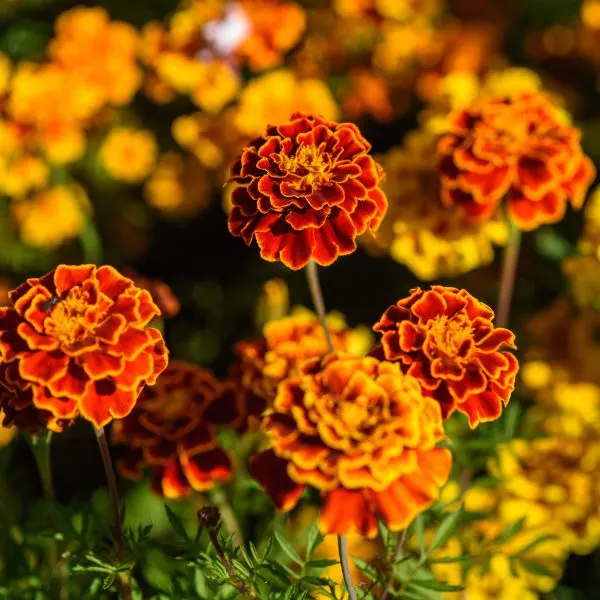
Marigolds are mostly herbaceous flowering annual or perennial plants which belong to the daisy family Asteraceae just like lettuce. They are good companions to Brussels sprouts for these two reasons: their flowers and their odor.
They have bold, beautiful and colorful flowers which come in different sizes and may be gold, orange, white or yellow in color. They also have a pungent odor and have green feather-like leaves.
The strong and sharp smell of marigolds is unpleasant to rabbits and some other pests that live in the ground. This odor masks the scent of Brussels sprouts, keeping the pests away from them.
Marigolds repel aphids, cabbage worms, cucumber beetles, nematodes, potato beetles, rabbits, squash bugs and whiteflies. They also attract hoverflies whose larvae prey on aphids. You can also use marigolds as trap crops.
Another way marigolds keep pests away from Brussels sprouts is by their flowers. The flowers attract aphids to the marigold instead of the Brussels sprouts. They also bring bees closer, and bees aid pollination.
While many different species of marigolds exist, they like full exposure to sunlight in general. Some are drought resistant and can stand low moisture levels. Others like moisture more but they all thrive in fertile, well drained soil.
Both Brussels sprouts and marigolds have similar growth and care needs generally. They need full sun, well draining soil and fairly even moisture levels. Their companionship tends to be convenient.
17. Mint
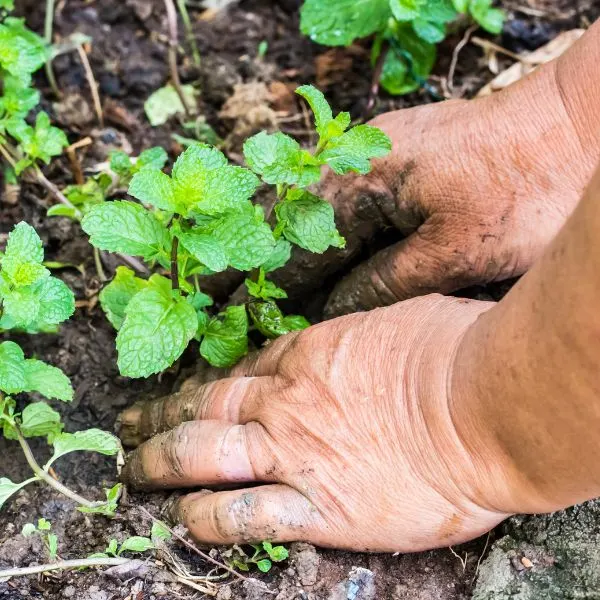
Mint is a genus of about sixty aromatic herbaceous flowering plants in the biological family Lamiaceae. Most plants in this genus are perennial, with several species, cultivars and hybrids, peppermint for example.
They have wide spreading runners underneath, on or above the ground. Such plants are native to the Old World (Africa, Europe and Asia). They are also suitable companion plants for Brussels sprouts, especially peppermint.
Mint encourages the growth of Brussels sprout by helping its taste and hiding its smell. It has a bold and pungent smell that masks the more subtle smell of the brassica and so protects it from the pests that would rather destroy the plant.
Although there is not much scientific evidence to prove this, mint is believed to help improve the flavor of Brussels sprouts. For the purpose of deterring pests, peppermint tends to be one of the best mint varieties.
Peppermint specifically deters aphids, cabbage moths and flea beetles. This variety of mint does not only keep harmful insects away, it also draws beneficial ones towards itself and the other crops around it.
Because mint plants have fast growing horizontal roots, they easily take over any area where they are planted. For this reason, it is better to prevent this spread. To do this, plant them in a pot separate from your Brussels sprouts.
This way, mint does not compete with your brassica, which is a heavy feeder, for soil nutrients, root space, water and sunlight. Some other plants can be added to the area so that they can benefit from mint as well.
18. Nasturtiums
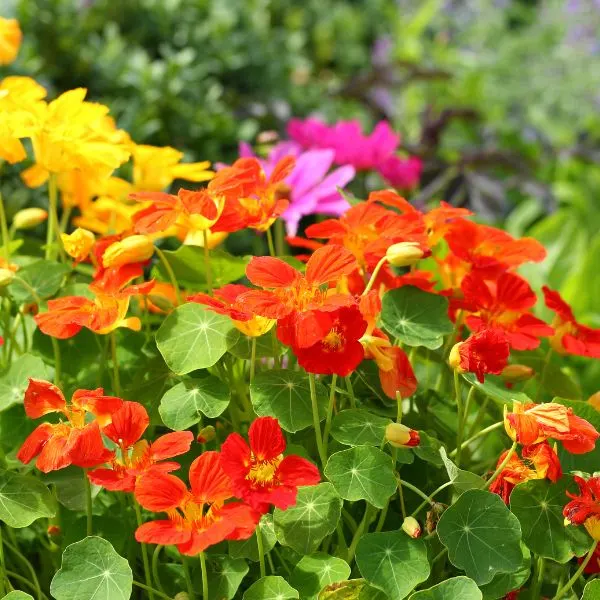
Also known as tropaeolum, nasturtium is a genus of close to a hundred species of annual and perennial herbs. They have showy round flowers and are used in herbal medicine, for culinary purposes or in the control of pests.
Nasturtiums are also good companions for Brussels sprouts. They repel several insects that harm brassicas in general, like aphids, cabbage worms, cabbage loopers, flea beetles and whiteflies by the peppery and astringent smell that they have.
As creeping plants, they can serve as ground cover. They can take up free ground space, maximizing your garden space. They also inhibit the growth and activities of weeds and help curb erosion.
In inhibiting the growth and spread of weeds by serving as ground cover, nasturtiums reduce unhealthy competition between your Brussels sprouts and weeds for soil space and nutrients. They are used in pest control as trap crops because of their beautiful and showy flowers.
Trap crops attract pests (in this case aphids, beetles and whiteflies) which would otherwise destroy the plants they are protecting (the Brussels sprouts). With their flowers too, they are able to attract beneficial insects to the garden.
Nasturtiums do not use up too much nutrients from the soil m so they do not compete with Brussels sprouts, which need and use up large amounts of nutrients.
A minor issue may be their drought tolerance, as they would rather have moderate amounts of water than too much. This aside, they like full sun and rich, well drained soil just like the Brussels sprouts do.
19. Onions
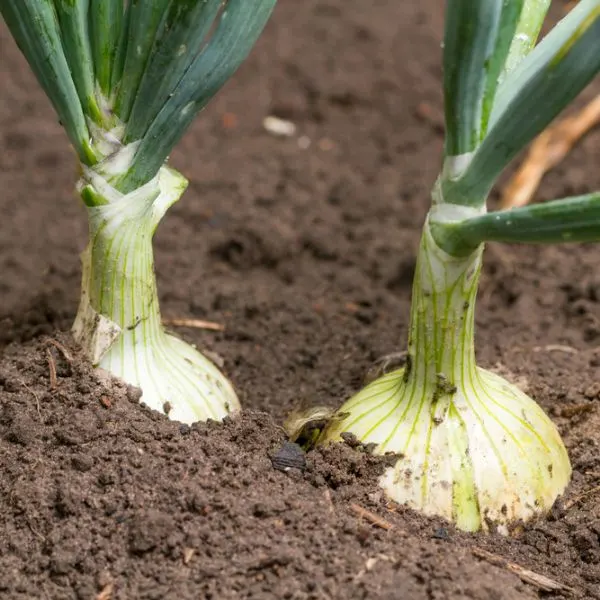
Onions are the most widely cultivated vegetables in their genus, the genus Allium. Also called bulb onions or common onions, they are close relatives of chives, garlics and scallions. The onion plant produces a sharp odor.
This strong aroma covers the scent of Brussels sprouts, keeping pests away from these plants. Pests like aphids and caterpillars, which specifically feed on brassicas, and others like Japanese beetles and rabbits, are some of the pests that onions deter.
It is also believed that onions improve the flavor of the plants and vegetables grown around them. Growing Brussels sprout near an onion plant can enable the brassica benefit in this way from the flavor-enhancing allium.
Planting the pair close by is quite ideal due to convenience, as a heavy feeder like Brussels sprout needs light feeders like onions as companions. This way, competition is either significantly reduced or completely eliminated.
Also, both plants need full exposure to sunlight daily, though onions need lots of water to form properly. The fact that onion plants deter several pests themselves notwithstanding, they are still susceptible to attacks from onion flies.
Grow another pungent plant, like mint, nearby for this reason. When mint is grown near onion plants, its scent can mask that of onions, confusing the onion flies that find their food by smell. This preserves your onions.
The onions in turn repel some other pests of mint. They can help keep these pests away from your mint, Brussels sprouts and other plants around them. A combination of the pungent odor of both plants can deter more pests from your garden.
20. Oregano
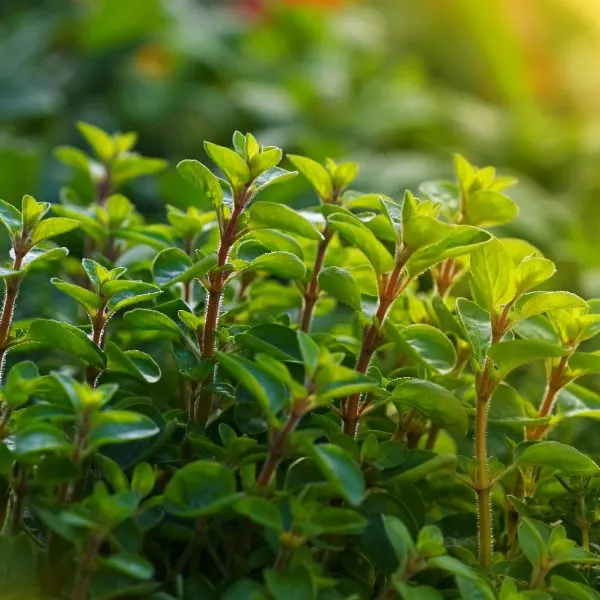
Oregano is a woody perennial plant that belongs to the mint family Lamiaceae. It is a herbaceous flowering plant, which means that it is an aromatic plant with a strong odor and it produces flowers by which it reproduces.
Like some other plants in the mint family, oregano is a good companion plant for your Brussels sprouts. As a flowering perennial plant, it may be harvested after a growing season but its flowers may not have bloomed yet.
When allowed to blossom, the beautiful flowers of the oregano plant draw several beneficial insects to your garden. They may be agents of pollination, like bees and butterflies, or predatory ones like ladybugs that feed on crop pests.
The flowers of the oregano plant may be pink, pinkish purple, purple or white. They are an attractive addition to your garden, possessing the ability to bring useful insects and animals to the garden even while keeping pests away.
Hummingbirds, green lacewings and ladybugs are some beneficial animals that the flowers of oregano attract. They are all great pollinators for your plants and they also prey on several pests of Brussels sprouts.
Hummingbirds eat flies, ants, aphids, mites, beetles, weevils and mosquitoes. The larvae of lacewings are ferocious predators of aphids. Ladybugs feed on aphids, mealybugs, thrips, maggots, mites, beetles and whiteflies.
Even without its flowers, oregano is beneficial to Brussels sprouts. Its strong, pungent smell is able to keep some pests away. The oregano itself can repel such insects as flies and mosquitoes.
If you intend to grow oregano and Brussels sprouts together, plant them in a sunny spot for the best results. Oregano is tolerant of low moisture conditions, as it needs moderate amounts of water, so it would not compete with your plant.
Regarding growth needs and requirements, both plants have similarities. They both prefer to be grown in full view of the sun and suffer stress in soggy soil. While oregano is drought tolerant however, Brussels sprouts prefer periodic and even watering.
21. Parsley
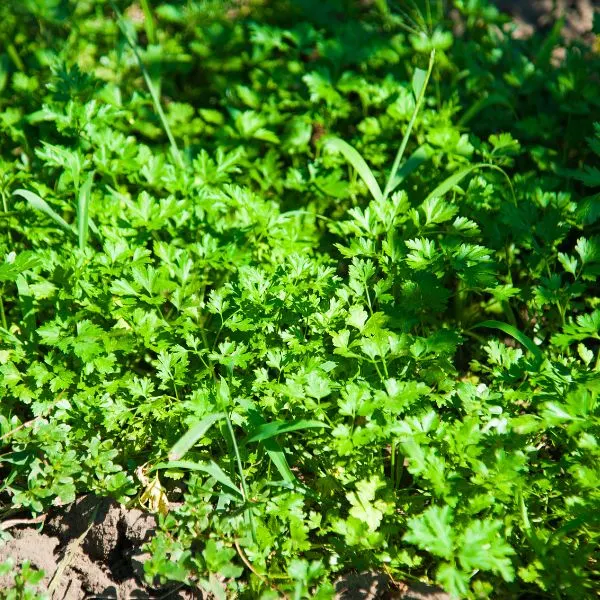
Parsley, also less commonly called garden parsley, is a flowering plant cultivated widely across the world for use as a medicinal herb or in cooking as a vegetable. This aromatic plant belongs to the biological family Apiaceae, like carrots.
Parsley is a very good companion plant for your Brussels sprouts. It is fairly easy to grow, repels several common pests and attracts useful insects. It encourages the growth of many plants near it by so doing and therefore makes for a healthy plant environment.
Several pests are known to be drawn to Brussels sprouts and other plants in the Brassicaceae family, including aphids, cabbage loopers, cabbage moths, flea beetles, whiteflies and several other kinds of flies
However, with parsley around, the infestation of these bugs is significantly reduced. The herbaceous plant attracts insects that prey on them and other plant pests. Hoverflies, tachinid flies and beneficial wasps are some pest predators.
The larvae of hover flies eat aphids and thrips. Tachinid flies are parasitic, feeding on beetles, caterpillars, squash bug nymphs, stink bugs and larvae of other flies. Asparagus beetles and some other beetles are repelled by parsley too.
Parsley also fares great with Brussels sprouts as they need similar growing conditions. They both prefer full exposure to sunlight and moist but well draining soil. Parsley, however, tends to be more drought resistant than Brussels sprouts.
22. Peas
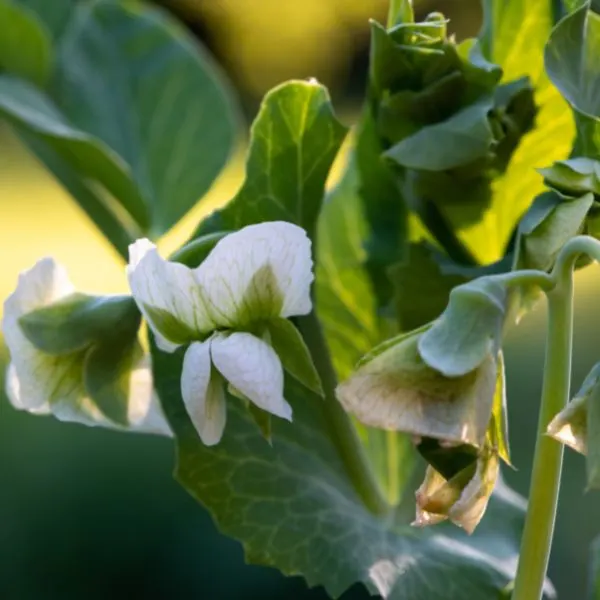
Peas are herbaceous flowering annual plants in the same biological family as beans, Fabaceae. Also known as garden peas, these plants are cultivated in various parts of the world for their edible seeds. They are not vegetables but they are cooked as such.
Like beans, they are leguminous plants, meaning that they fix nitrogen in the soil. They replenish used up nutrients in the soil this way, so they are very crucial and effective for heavy feeders like Brussels sprouts.
Unlike Brussels sprouts, peas do not like full exposure to direct sunlight but rather prefer cooler and more shaded areas to grow and mature properly. But like Brussels sprouts, they require moderate amounts of moisture.
Another reason peas are so ideal to be planted with Brussels sprouts is that their roots are shallow. They will most likely not compete with your Brussels sprouts for water, soil space and soil nutrients.
23. Peppermint

Peppermint is a hybrid of water mint and spearmint, two species in the genus Mentha (mint). Growing it beside your Brussels sprouts in the garden is not the most ideal as it spreads quickly and competes for nutrients with the plant.
Like other mint plants, it can prove helpful to Brussels sprouts if it is grown in a container or pot and kept in your garden. Although it still requires lots of care and nutrients, it does not compete with your sprouts for nutrients this way.
The strong scent of peppermint wards off pests like aphids and cabbage moths. Also, its flowers attract bees, hoverflies and parasitoid wasps that eat pests. It may also serve as a trap crop for caterpillars, flea beetles and nematodes.
24. Radishes
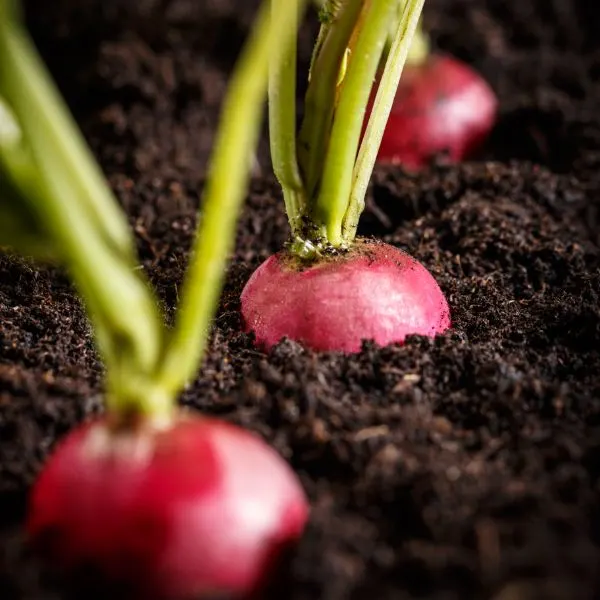
A radish is a root vegetable also belonging to the biological family Brassicaceae, the cabbage family. Its roots are edible and so are the leafy greens atop them. They may be eaten raw, which they mostly are, or cooked.
There are several cultivars of radishes in different colors, sizes and shapes. The edible roots and green leaves above it are typically eaten raw as a salad vegetable or with other foods after being cooked by several cooking methods.
Radishes need care and nutrients similar to those that Brussels sprouts need. This is a comfortable relationship but planting them together may not be the most ideal as radishes attract flea beetles, pests that destroy the leaves of sprouts.
Be that as it may, radishes are beneficial for the fact that they help to loosen the soil surrounding your Brussels sprouts. This allows the plants more room to absorb the water and nutrients that they need.
Radishes also need lots of nutrients and water to grow very well and so it is likely to be a competitive environment for Brussels sprouts if they have to grow in the same soil. This can however be solved by adequate spacing
Animal and insect pests, including aphids, cabbage loopers, cutworms, deer and flea beetles attack radishes and some of these are also attracted to Brussels sprouts. Other measures may be put in place for the purpose of pest control.
Because both plants are flowering crops, they help improve the growth and vigor of each other. By their flowers, they can attract useful pollinators to the garden to aid the development of your Brussels sprouts.
25. Rosemary
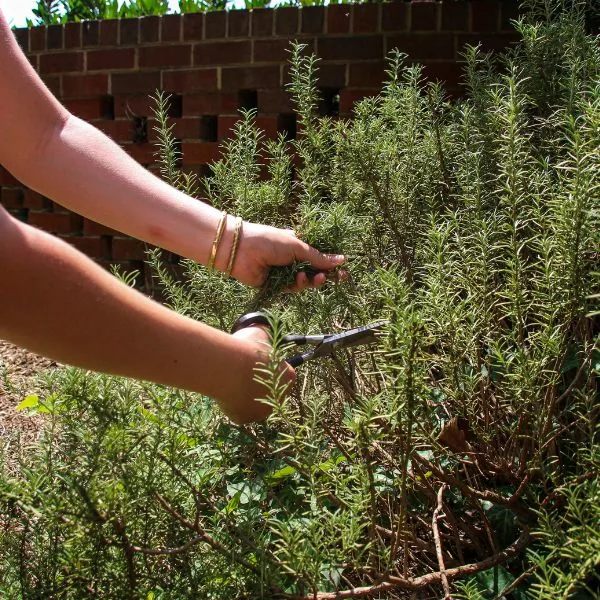
Rosemary, scientifically called Salvia rosmarinus, is a low, woody perennial plant with thin and needle-like leaves which are fragrant and evergreen. The flowers of this plant may come in blue, white, pink or purple.
It is another herbaceous flowering plant in the mint family Lamiaceae. It provides several benefits to Brussels sprouts and its fellow brassicas. The plant produces an essential oil, hence its scent.
Its scented oil repels different insects like moths, rust flies and cabbage moths (which lay cabbage worms or cabbage loopers). This is because of the strong scent of the essential oil of rosemary.
The plant prevents the infestation of pests this by masking the scent of the brassicas so that these plant pests do not get drawn to them and destroy your crops. Brassicas benefit from the presence of rosemary around them.
Rosemary’s presence is also believed to help improve the flavor and taste of other garden plants. Sowing any vegetable in the family Brassicaceae, like Brussels sprout, near rosemary in the garden is good.
26. Sage
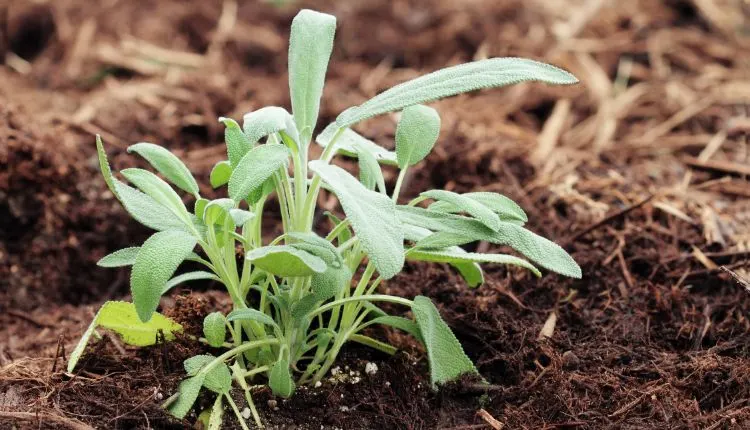
Sage, otherwise known as common sage, is a perennial plant easily distinguished by its grayish leaves and blue to purple flowers. It is another herb in the mint family Lamiaceae which is beneficial to your brassica. It is aromatic, bushy and edible.
The companionship is first suitable because while Brussels sprout is a heavy feeder, sage is a light feeder. This already means that competition for nutrients, soil space and nutrients will be very minimal and both won’t affect each other’s health.
Its beautiful flowers attract insects that aid pollination. These insects help improve harvests in the garden, boosting the health of your plants including the Brussels sprouts. Such pollinators include bees and butterflies.
In addition to this, the aroma of sage is strong and can help keep several pests that attack Brussels sprouts away. Some of these pests are black flea beetles, cabbage maggots, cabbage loopers, rust flies and cabbage moths.
27. Shallots

Growing shallots alongside Brussels sprouts lends the same benefits as onions. Shallots are small bulb vegetables in the same family as onions: Allium. They are close relatives of garlic and chives, used for seasoning food.
Shallot plants are aromatic like other alliums. Their pungent smell keeps different pests away from the crops in your garden. When planted next to Brussels sprouts, shallots deter insects that would otherwise be harmful to the plant.
Like radishes, shallots loosen up the soil around the roots of Brussels sprout plants. By doing so, your Brussels sprouts are able to take up needed nutrients and water. Their roots then also have enough space to grow properly.
28. Spinach
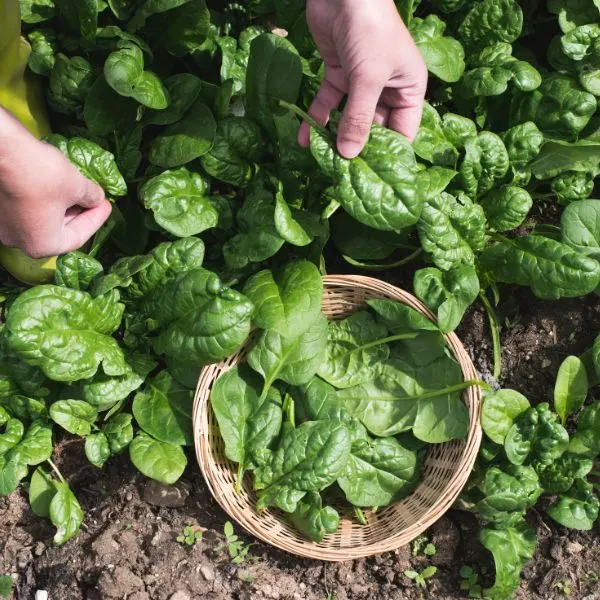
Spinach is a flowering plant in the amaranth family. Its green leaves are edible and commonly eaten as a vegetable either raw or after preservation. Spinach is a good companion plant for Brussels sprouts.
Although it does not necessarily add much to your plant, its roots grow to a different soil level than those of Brussels sprouts. The both species also have different nutrient requirements. For these reasons, spinach does not compete with your Brussels sprouts.
Instead, they live and grow peacefully when planted next to each other. Also, spinach serves as a good ground cover, filling holes and spaces within your garden. This maximizes the potential and space of the garden.
29. Thyme
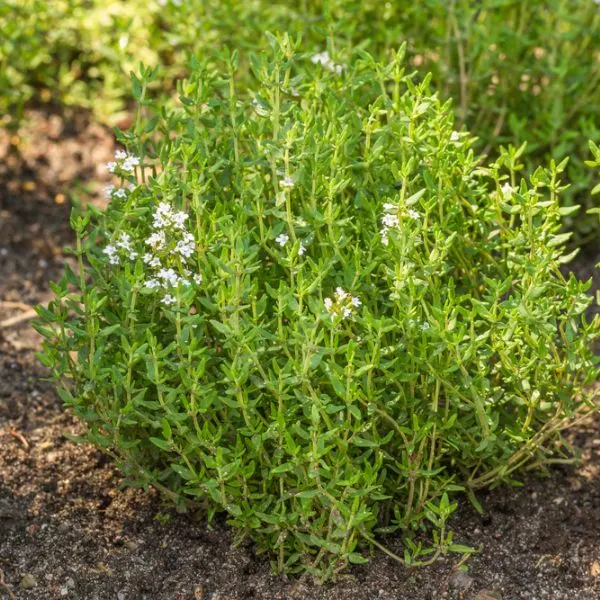
Thyme is an aromatic evergreen herbaceous plant in the mint family Lamiaceae. It is a perennial flowering plant closely related to mint, oregano and sage. It is yet another herb that grows well near rhubarb, a good companion plant for it.
Another herb you can conveniently plant beside Brussels sprouts is thyme. It is one of the best companions this plant could have. It provides ground cover, deters pests from the garden and attracts pollinating insects to your plant.
By providing ground cover, the roots of your Brussels sprouts are kept cool by thyme and weeds are prevented from growing. Thyme has a very strong scent which masks the scent of the sprouts, keeping pests away from them.
Cabbage worms, corn ear worms, tomato hornworms and whiteflies are some pests of Brussels sprouts that thyme repels. This plant not only keeps pests away; it is able to attract beneficial ones like pollinators to the area.
When the plant is in bloom, the flowers of thyme bring useful insects to your plant that aid pollination or eat pests. Thyme plants are far more drought resistant than Brussels sprouts. For this reason, they do not compete with each other.
Despite thyme’s drought tolerance, it grows well beside the sprouts. You should be careful with this pairing however. This is because if adequate spacing is not given between the two, only one would thrive while the other dies.
Planting thyme next to Brussels sprouts will also help prevent any root rot in their wet soil. Root rot is caused by a fungus in the soil. Thyme has antifungal properties, as it contains thymol and carvacrol which make it suitable for preventing this fungal disease.
30. Yarrow
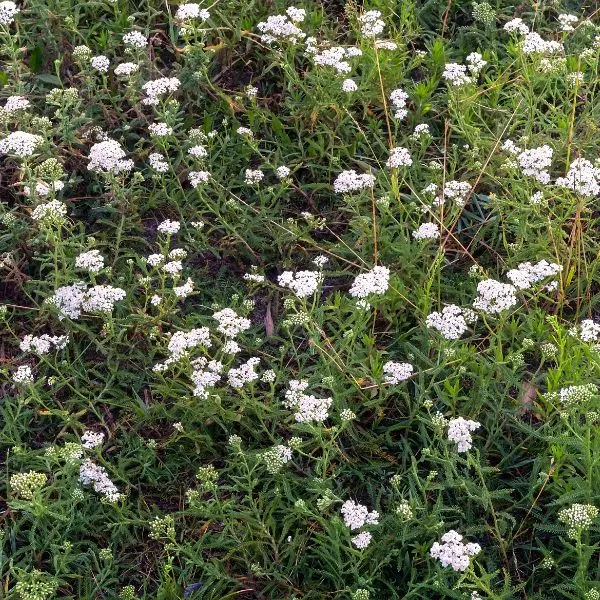
Also known as old man’s pepper, sanguinary, devil’s nettle, soldier’s woundwort or common yarrow, yarrow is a flowering herb in the aster or daisy family Asteraceae. It has a sweet scent and its flowers may be white, yellow, pink or red.
Yarrow has several medicinal uses. It has been used in traditional medicine for hundreds of years. This plant has a smell that is unpleasant to several harmful insects and so it benefits your Brussels sprouts.
The smell does not adversely affect butterflies which are agents of pollination. Yarrow’s attractive flowers bring useful insects to Brussels sprouts. Some are hoverflies, lacewings, ladybugs and parasitoid wasps which prey on aphids.
So yarrow is beneficial to Brussels sprouts as it keeps some insect pests away from your plant. It also attracts beneficial insects to your garden. These insects aid pollination or prey on other insects that cause harm to Brussels sprouts.
Yarrow is a wildflower which grows best in full sun and moist, well draining soil. It is a drought resistant plant that prefers to be underwatered rather than overwatered. If placed under full or partial shade, it tends to grow long and straggly.
So when planting yarrow with Brussels sprouts, make sure to place them in an area with adequate sunlight to get the best results. This positioning will be of great benefit to both plants as they need the full sun exposure for optimal growth.
Pollinators like bees and butterflies will likely come to the area on account of the plant. Pest predators such as green lacewings, hoverflies, lady beetles and parasitoid wasps will come as well.
All the insects above help control aphids which Brussels sprouts and other brassicas are easily susceptible to. Hoverflies also feed on whiteflies and thrips. Parasitoid wasps and their larvae prey on whiteflies and caterpillars too.
Bad Companion Plants for Brussel Sprouts
1. Broccoli
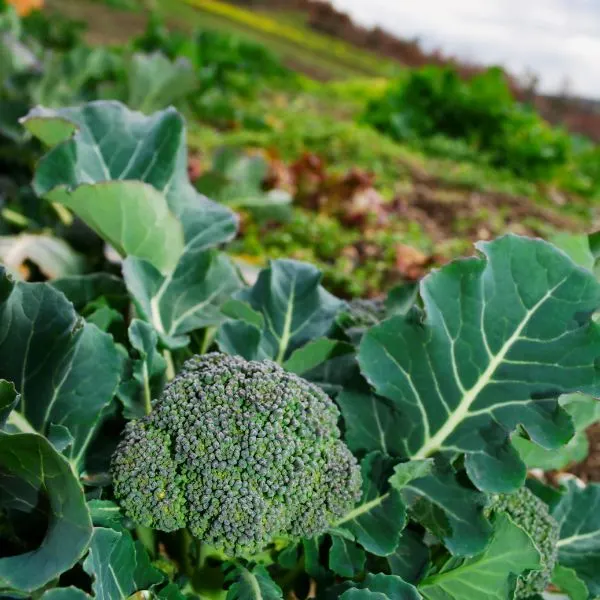
Broccoli is a flowering plant in the family Brassicaceae, the cabbage family. It has large, partly developed green flowers that make up its head, stalks and leaves which are the edible parts of the plant, the main reason it is cultivated.
Other brassicas generally do well beside Brussels sprouts. They are easily taken care of because they all have the same care and nutrient requirements. Despite this, avoid planting them side by side as it is detrimental to your Brussels sprout.
Although broccoli provides good ground cover and helps fill empty spaces in your garden, it has a tendency to battle for soil nutrients with Brussels sprouts. This is because both plants are heavy feeders and so require more nutrients than most other plants do.
In addition to needing and competing for similar nutrients to Brussels sprouts, broccoli attracts several pests that also harm the sprouts to itself. These crops should be kept away from each other with good companions between them.
2. Cabbage

Cabbage is a flowering biennial plant mostly grown as a vegetable crop for its edible and tightly packed leaves. Its leaves are layered and may be white, red or green in color. It is another bad companion plant for Brussels sprouts.
Like Brussels sprouts, cabbages are heavy feeders and they both have similar care requirements. Cabbages belong to the biological family Brassicaceae and so they are brassicas like broccoli, cauliflower, kale and kohlrabi.
It is not advisable to plant both of these crops side by side. They would suffer from similar diseases and spread them easily. Pests of brassicas would be more attracted to them. Also, these plants would compete for water and nutrients.
3. Cauliflower

Cauliflower is another flowering plant in the Brassicaceae family, cultivated for its partially developed flowers, referred to as the head or “curd”. The head is edible and mostly in the colors white, yellow, green, orange, brown or purple.
It is also a bad companion plant for Brussels sprouts. Growing them together is easy because they both belong to the same family and need similar amounts of light, water and nutrients.
This could lead to more problems than benefits because it means that both crops would battle for water, nutrients and space in the soil. Conflicting views exist on the topic of pests and diseases.
Because brassicas are susceptible to attacks from the same pests, one of two possibilities may occur. Pests may be more attracted to that area of your garden, causing more damage, or the damage may reduce, evening out between the crops.
4. Corn
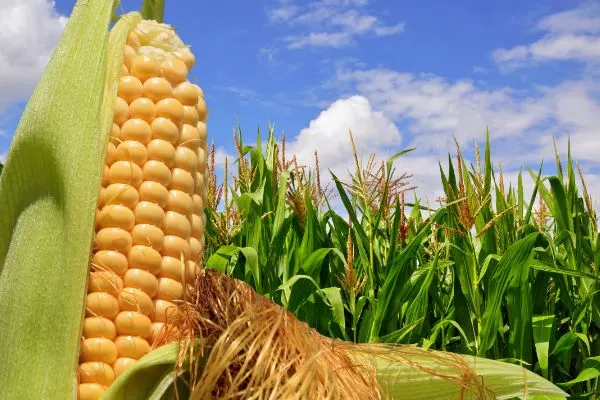
Corn or maize is a species of monocotyledonous flowering plants in the grass family Poaceae or Gramineae. Its leafy stalk produces separate inflorescences known as ears. When fertilized, these ears yield fruits, which are the seeds.
This species is not suitable for growing beside any plant in the cabbage family. It takes up too much sunlight from them because it is tall and shades these plants too much.
Brussels sprouts need full exposure to sunlight for optimal growth and results. Growing corn beside them takes this away and ends up stunting the growth of Brussels sprouts. Plant these two apart.
5. Eggplants
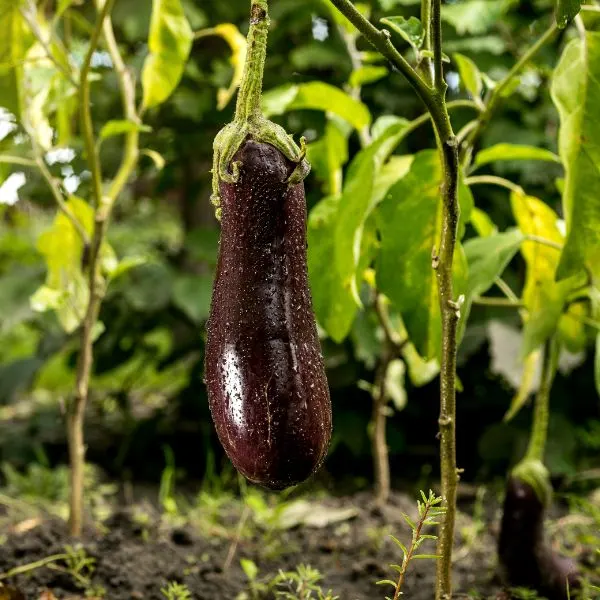
The vining plant called eggplant is also referred to as baby marrow, courgette or zucchini. It is a summer squash, a herb grown for its fruits which are harvested when they still have immature seeds and soft rinds that are edible.
It belongs to the nightshade family Solanaceae. Like plants in the cabbage family, nightshades tend to be heavy feeders as well. For this reason, competition can arise between them if they are played together.
Although eggplants, like Brussels sprouts, enjoy exposure to full sun, a companionship is not advisable between these two. Nightshades like eggplants should not be planted next to Brussels sprouts as they will compete for the same nutrients.
6. Kale

Another brassica that should not be planted near Brussels sprouts is kale. Kale, also called leaf cabbage, is a cabbage cultivar grown for its edible green or purple leaves, or for use as an ornamental plant. It is a bad companion for this plant.
Although kale can deter pests from attacking your Brussels sprouts, it is a heavy feeder too. It would battle with your plant for the nutrients and space in the soil. Also, they attract the same pests and can easily share diseases.
7. Kohlrabi

Yet another brassica you should not plant with your Brussels sprouts is kohlrabi. It is a variety of wild cabbage with thin stems and yellow flowers also known as the German turnip. Its stems and leaves are edible and it tastes very much like cabbage.
As with other plants within this cabbage family, separate the sprouts from kohlrabi. This avoids the unnecessary and unhealthy competition for root space and soil nutrients that would otherwise occur if they are planted side by side.
The companionship would be ideal and comfortable because they both need similar care for their development. However, pests and diseases will be easily distributed and transmitted in such an area in addition to the competition. Both plants would not fare well, or one would thrive while the other dies.
8. Pepper Plants

Like eggplants and tomatoes, pepper plants are flowering plants of the nightshade family. Several species and cultivars exist, even in various colors like red, yellow, orange, green, white and purple.
Peppers should not be planted in close proximity to your Brussels sprouts. This is because they compete for nutrients with it, take up too much sunlight and attract similar animal and insect pests to your garden.
Both Brussels sprouts and pepper plants are susceptible to attacks from aphids, flea beetles and spider mites. For this reason, it is not advisable to grow them side by side in the same soil.
Peppers also need less moisture than Brussels sprouts do. They prefer to be dry than too wet. Like your sprouts, they also like full sun for proper growth and because they grow taller, they take up too much sunlight.
9. Pole Beans
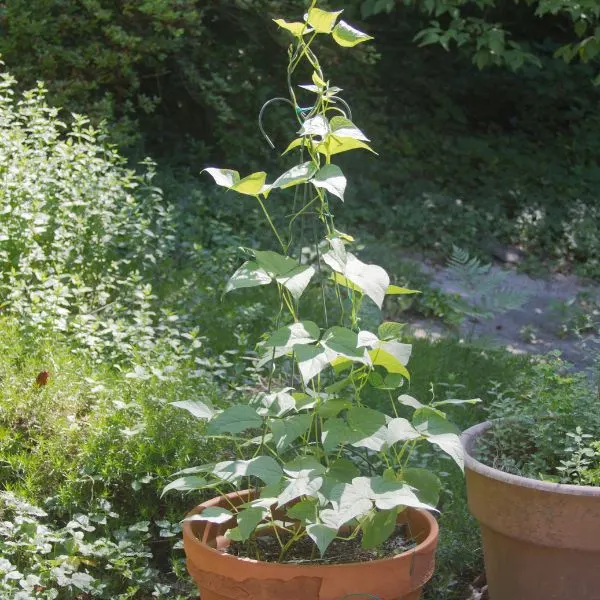
Pole beans, runner beans, butter beans, scarlet runner beans or multiflora beans are flowering plants in the pea or legume family Fabaceae. They are grown both as food plants and as ornamental plants.
Notwithstanding the fact that pole beans are legumes and legumes are beneficial to the soil (by improving the nitrogen content of the soil thereby replenishing used up nutrients), do not plant them alongside your Brussels sprouts.
Pole beans can grow to about three to five times the length of Brussels sprout plants at maturity. This is detrimental to the health of Brussels sprouts as their access to sunlight is more limited. This means your sprouts may receive inadequate amounts of sunlight and become stunted.
10. Potatoes
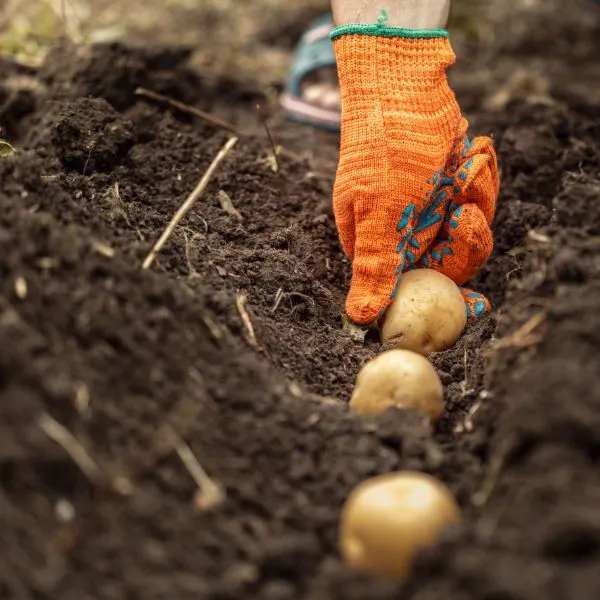
Potatoes are perennial root vegetables belonging to the family of nightshades known as Solanaceae. They are starchy tubers with their vegetative and fruiting parts toxic for human consumption (because they contain a toxin solanine).
They are bad companion plants for Brussels sprouts. Both plants bring several disadvantages to each other. Brassicas and nightshades should not be grown together generally, as brassicas can stunt the growth of potatoes.
Both potatoes and Brussels sprouts need many nutrients from the soil for proper development. They also have similar care needs and are plagued by similar pests and diseases. This companionship will not be beneficial in any way.
Potatoes have deep roots that the shallow roots of Brussels sprouts and other brassicas do not compete with. Regardless of this, brassica crops need extra calcium, and if there is too much calcium in the soil, potatoes begin to develop scab.
Some pests that both potatoes and Brussels sprouts get attacked by include aphids, flea beetles, spider mites, mice and other rodents. Each of them should be cultivated beside other crops that can help protect them against pest activities.
11. Pumpkins
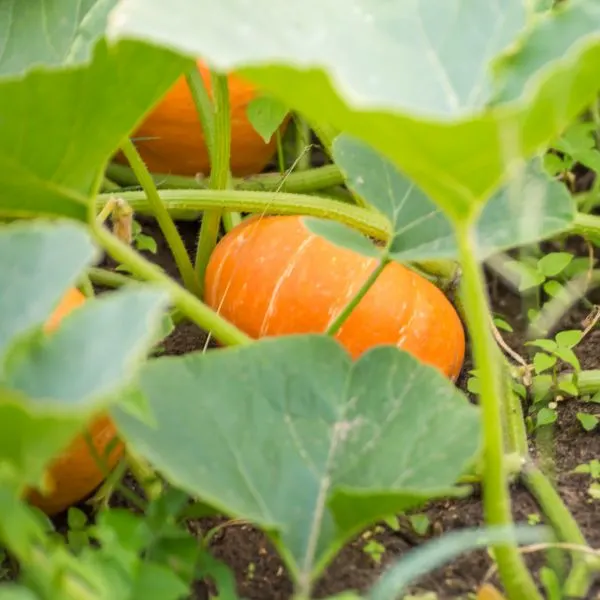
Pumpkins are cultivars of winter squash (fruits of plants in the genus Cucurbita that have hard rinds, mature in winter and may be stored for several months) that are round in shape and ribbed on their skin. They have deep yellow to orange skin and inside, they contain seeds and pulp.
Pumpkin plants are not good companions for Brussels sprouts because they shade these plants too much. Although Brussels sprouts require cool weather, pumpkin plants grow too tall. They end up taking up too much sunlight.
When pumpkins grows beside Brussels sprouts, the latter do not get adequate sunlight. Sunlight is paramount for the growth and health of your plant by photosynthesis. Pumpkin shades the plant too much, blocking it from the sun.
12. Strawberries
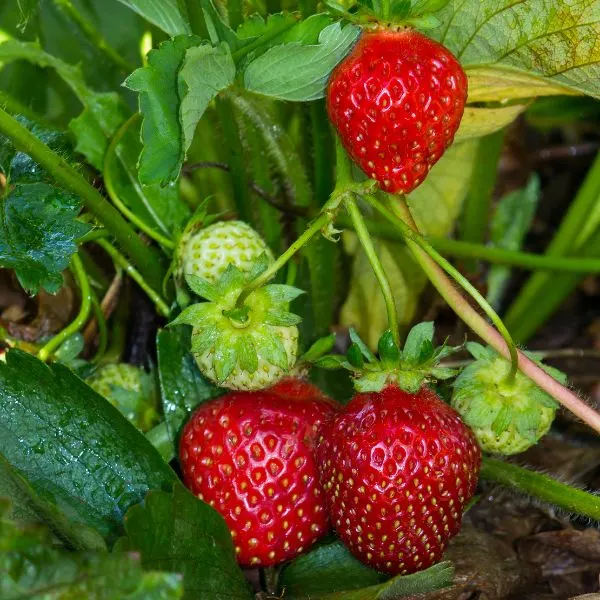
One of the worst companion plants for Brussels sprouts is strawberry. Strawberries are not ideal for cultivation beside any plant in the family Brassicaceae. They are poor companions to crops like these.
Strawberries are low perennial herbs with many runners and white flowers. They produce edible fruits which are small achenes scattered on the surface of an expanded red pulpy berry.
Brussels sprouts and other brassicas are adversely affected by the presence of strawberries grown in close proximity to them. These berries contain allelochemicals which can inhibit the growth of your Brussels sprouts.
Strawberries also attract destructive insects to your crops. They are known for attracting slugs and snails, two terrestrial invertebrates that are notorious for eating away at the leaves of plants like Brussels sprouts, destroying them and inhibiting their growth.
13. Tomatoes

Tomatoes are South American plants of the nightshade family Solanum. They produce a widely grown mildly acidic fruit also known as tomato, with many varieties. Tomatoes are a glossy red or yellow color, pulpy and edible, eaten raw or cooked.
Yet another very bad companion plant for Brussels sprout is tomato. Planting tomatoes and Brussels sprouts side by side can cause harm to both plants. Brassicas generally stunt the growth of tomatoes with their own allelochemicals.
Like plants in the Brassicaceae family, tomato is a heavy feeder. It needs a lot of water, nutrients and care for the best results. Placing these two crops beside each other makes them compete for nutrients.
A competition for nutrients will result in one or both of the plants being stunted. The crops are not allowed to grow and produce to their full potential. So for the best results, keep tomatoes and Brussels sprouts far apart.
FAQs
What can you not plant next to Brussels sprouts?

Some crops that you should not plant next to Brussels sprouts are other brassicas (like broccoli, cabbage, cauliflower, kale and kohlrabi), nightshades (like eggplants, pepper plants, potatoes and tomatoes), corn, pole beans, pumpkins and strawberries.
Can you plant lettuce with Brussels sprouts?
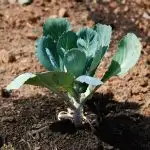
Yes, you can plant lettuce with Brussels sprouts. The two plants do not inconvenience each other, as they both like full exposure to sunlight, consistent and even watering, and moist but not soggy soil. They both have flowers and so they can foster the process of pollination.
Can cucumbers and Brussels sprouts be planted together?
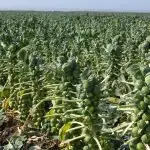
Yes, cucumbers and Brussels sprouts can be planted side by side without much complications. Cucumbers are vine plants that need ground space to crawl while Brussels sprouts are more compact; planting them together helps maximize space in your garden. The strong, sharp odor of cucumbers keeps cabbage root flies away and a compound they contain, known as cucurbitacin, stops the growth of fungal diseases. Cucumbers also fare well beside Brussels sprouts because both plants have similar growth needs.
Can peppers and Brussels sprouts grow together?

No, peppers and Brussels sprouts cannot grow well together. This is because peppers compete for nutrients with Brussels sprouts, take up too much sunlight and attract similar pests to that area of your garden.
Do Brussels sprouts like full sun or shade?
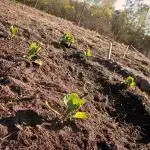
Brussels sprouts prefer to be grown in full sun rather than in the shade. This optimizes their growth and health.
Conclusion
Brussels sprouts are edible vegetables resembling miniature cabbages in the family Brassicaceae. Listed and explained above are thirty (30) good companion plants for Brussel sprouts and thirteen (13) bad companion plants for these biennial crops.
The plants provide several vitamins and minerals, including vitamins B1 (thiamine), B2 (riboflavin), B3 (niacin), B5 (pantothenic acid), B6, B9 (folate),C, E and K, calcium, iron, magnesium, phosphorus, potassium, sodium and zinc.
In addition to the many nutrients they contain, Brussels sprouts are high in fiber, water and antioxidants. They may help protect against cancers of the stomach, lungs, kidney, breast, bladder, and prostate.
Cruciferous vegetables like Brussels sprouts can likely also ward off other health issues within the human body, such as high blood pressure, high cholesterol, heart disease and diabetes.
While growing Brussels sprouts, remember that they need full exposure to sunlight, moist and well draining soil, cool weather (it is ideally grown in early spring or mid to late summer to mature in autumn), and even, intervallic watering for the soil.
More companion plants
